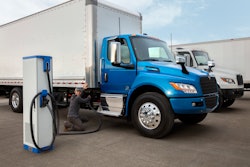When trucking goes electric it will transform not only the industry, but also the country and its physical layout, according to a new study from National Grid, one of the world's largest publicly listed utilities.
The study looks at 71 sites across New York and Massachusetts, where national grid operates in the U.S., and Geotab’s ITS Altitude transportation analytics platform to estimate how much power charging site will need if these states are to hit their emissions goals. As both states have adopted California's Advanced Clean Trucks regulations, they're slated for a phased progression to 100% zero-emissions medium and heavy duty vehicle sales by 2045.
The chart below shows how these sites will have to grow until many are consuming as much electricity as a small town or a large factory. In short, the demand for on-highway fast-charging will have a massive impact on the grid. By 2030, a typical highway gas station will need as much power as your favorite major league sports stadium. By 2035, that could climb to the level of a small town. By 2045, a simple truck stop could demand as much power as an automotive manufacturing plant or aluminum refinery.
 When power demand crosses the dashed line, regular low-wattage lines will no longer do the trick, and charging sites will need access to high-voltage lines.National Grid
When power demand crosses the dashed line, regular low-wattage lines will no longer do the trick, and charging sites will need access to high-voltage lines.National Grid
While these numbers may seem eye-popping today, remember that the U.S. already transformed itself into a nation of billions of miles of road and 64,000 gas stations once before. While the challenge of electrification looms large, the study's authors and other experts were confident that the nation can once again meet the task.
Perhaps the biggest takeaway from National Grid's study shows fortune favors the trucking industry. Truck stops, for the most part, sit along highways, and so do a lot of high-voltage transmission lines, the study's authors said.
"These are places where it makes sense to do big charging installations because the transmission is right there," Charlotte Fagan, one of the study's authors said. "We can bring the chargers to the big wires instead of bringing the big wires to the chargers."










